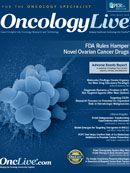Publication
Article
Oncology Live®
Novel Tomography System May Help Guide Therapy in Early Breast Cancer
Author(s):
Diffuse optical tomography (DOT) is a novel, fast, safe, and low-cost technique that uses near-infrared light to provide three-dimensional data on tissue vascularity without the use of radiation.
Kevin Kalinsky, MD, MS
Assistant Professor of Medicine
New York-Presbyterian Hospital/Columbia University Medical Center
Breast Cancer Program at the Herbert Irving Comprehensive Cancer Center
Diffuse optical tomography (DOT) is a novel, fast, safe, and low-cost technique that uses near-infrared light to provide three-dimensional data on tissue vascularity without the use of radiation. Columbia University oncologists have been studying whether a system developed at the university can help guide physicians in evaluating chemotherapy and antiangiogenic treatment options for patients with early breast cancer.
Andreas H. Hielscher, PhD, a professor of Biomedical Engineering, Electrical Engineering, and Radiology at Columbia, has designed a digital continuous wave system that images both breasts at the same time at fast-frame rates, with a large number of sources and detectors. As opposed to mammography, no compression is required. As compared with magnetic resonance imaging, there is no need for intravenous injection or to be in an enclosed space.
Predictive Value for Chemotherapy
Columbia researchers wanted to determine whether DOT could be used as an early predictive tool for patients with locally advanced or high-risk breast cancer receiving neoadjuvant chemotherapy. The study focused on early changes in DOT-derived parameters for concentrations of oxyhemoglobin (HbO2), deoxyhemoglobin (Hb), total hemoglobin, and tissue scattering.1 These values then were compared with the pathologic response to chemotherapy, as measured by residual cancer burden (RCB) score.
Beginning in July 2011, investigators have enrolled approximately 30 women with stage II-IIIC invasive breast cancer in a clinical trial. All patients undergo neoadjuvant chemotherapy with 12 cycles of a weekly taxane followed by four cycles of doxorubicin with cyclophosphamide.
DOT has been employed six times during the chemotherapy, including a baseline and follow-up images 2 weeks after starting chemotherapy. The study is still ongoing, and several enrolled patients have yet to complete treatment and undergo surgery. However, the preliminary findings have been significant.
As reported at the San Antonio Breast Cancer Symposium in 2012,2 approximately 40% of patients were pathologic responders to neoadjuvant chemotherapy as measured by RCB, and 60% were nonresponders. Notably, 2-week changes in various DOT-derived parameters, such as Hb and HbO2, strongly correlated with pathologic response. At the 2013 San Antonio Breast Cancer Symposium, updated data will be presented.
In summary, the study has shown that 2-week changes in DOT-generated characteristics predict which patients are likely to have a pathologic response to neoadjuvant chemotherapy. The ultimate benefit of this imaging system may be that it gives physicians a tool to determine who is likely to respond at the time of surgery and who is not. This study is ongoing, as it has been expanded to include patients with different subtypes of breast cancer.
Bevacizumab Markers Studied
Starting in early 2014, a second study will use DOT to investigate how the imaging system predicts response to neoadjuvant bevacizumab plus chemotherapy in 25 patients with triple-negative or luminal B breast cancer. Specifically, the trial will seek to identify DOT-derived markers that can distinguish between responders and nonresponders to neoadjuvant antiangiogenic therapy, for which bevacizumab is the “gold standard.”
Researchers hypothesize that changes in DOT-derived parameters, after 14 days of bevacizumab, will associate with pathologic response at the time of surgery, as measured by the RCB score.
Although antiangiogenic drugs have shown promise, there are no biologic markers or clinical characteristics that identify which patients benefit from these therapies. Since some patients clearly benefit from these drugs, it is highly desirable to develop noninvasive biomarkers that predict patient response.
Reference
- Flexman ML, Kim HK, Gunther JE, et al. Optical biomarkers for breast cancer derived from dynamic diffuse optical tomography. J Biomed Opt. 2013;18(9):096012.
- Lim EA, Gunther JE, Flexman M, et al. Early optical tomography changes predict breast cancer response to neoadjuvant chemotherapy. Cancer Res. 2012;72(suppl 24; abstr P4-02-07).










